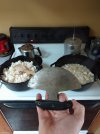Boattale
Gold Member
- Joined
- Nov 27, 2019
- Messages
- 2,582
It's a beautiful unmarked piece which was common at the time. My buddy says very few were marked in the early to middle 1800'sIt's a fairly common mold pre 1900s. A lot of foundry's used the pattern. It's one of my favorites of the style I have found as the gatemark isn't super pronounced and it dosent wobble on my electric coil burner.


